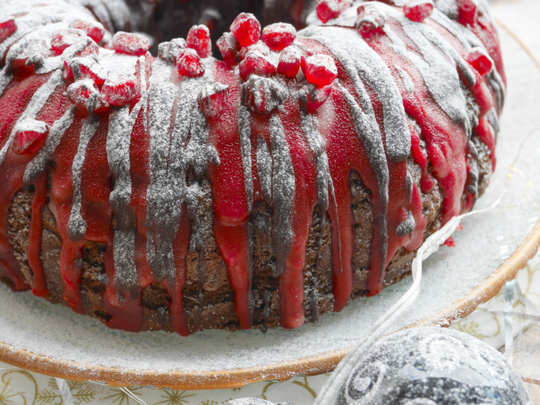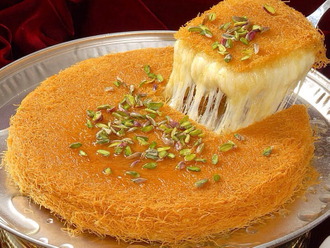
The history of the Christmas cake dates back to the 16th century. A very British tradition, the original recipe was more of a plum porridge mix, believed to be eaten to line the stomach after fasting.
Later, eggs and flour were added, along with spices and dried fruits. Traditionally round, richer families would cover the cake with marzipan and royal icing, similar to a wedding cake. My super baker gran would begin the three-month process around October, and it just wasn’t Christmas without the table centrepiece.
Dried fruit and mixed peel would be soaked for days, heaped spoons of brown sugar would be added along with flour and spices, and mixed. This was a big deal. The dining table would be cleared, and the family gathered, each taking a turn to combine the endless ingredients. Turning the mixture with a huge spoon was like a core workout.
Baked for hours, the cake base would go into storage for a few months. A week before the big day the dense, sweet smelling cake would be uncovered, smothered in apricot jam, covered with marzipan and then finally iced.
The final decoration would take place on Christmas Eve. Stored away for the year, the tin with cake decorations would be dusted off. The cake would be decorated to look like a winter wonderland. However, the cake was rarely cut until at least the middle of January — with endless leftovers to eat we just never got around to cutting it. Squares of cake would be part of my January lunch boxes; chunks were handed out to visiting relatives. By the end of the month they would be dry, and the not-so-royal icing would be impossible to cut without a small power tool.
These days you can buy cakes from the supermarket; the idea of a shop-bought cake back then would be unheard of. And although I have fond memories of the great Christmas cake countdown, nowadays it has become less a part of my Christmas celebrations.
Most people I know don’t like fruitcake and dislike marzipan even more — like me they would have cake left over well into the new year. So this year, refining my gran’s recipe for today’s tastes, I’ve created a centrepiece for the holidays. Ready in hours rather than months, this recipe is a take on my Bundt recipe, topped with some pomegranate seeds, icing and plain chocolate. I’m sure this won’t last until next week, let alone next year.
Here are a few timesaving tips for the big festive meal.
1. Make the gravy and freeze it, then defrost it the night before, adding some juices from the meat from the roasting tray for extra flavour.
2. Roll stuffing into golf ball sizes and place in freezer bags and freeze. Take out as many as you need for your meals over the holidays.
3. Vegetables like braised red cabbage can be prepared in advance, and stored. This actually improves the flavours.
4. Peel your potatoes the night before, keep them in a bowl in salted water and cover. Rinse, part boil, drizzle vegetable oil, add some garlic cloves, season and roast for 45-50 minutes.
5. Yorkshire puddings can be made ahead and just warmed up before the meal. This also gives you time for a remake if they aren’t as fluffy as you want.
FESTIVE ICED CHOCOLATE BUNDT CAKE
_resources1_16a085419c3_original-ratio.jpg)
Serves 12-14, prep time 15 minutes, cooking time 45-50 minutes
INGREDIENTS
350g caster sugar
6 free-range eggs
350g butter
300g self-raising flour
200g of cocoa powder
1/2 tsp baking powder
FOR THE DECORATION
8 tbsp of icing sugar
1 tsp of red food colouring
2-3 tbsp of cold water
4 squares of plain chocolate
Handful of pomegranate seeds
Icing sugar to dust
METHOD
Preheat the oven to 180 degrees.
Cream the sugar, eggs and butter in a food processor for five minutes. Sift the flour, cocoa and baking powder into a separate bowl. Then blend the ingredients for a further five minutes.
Meanwhile, with a pastry brush thoroughly grease the Bundt cake tin. Remove the mixture from the food processor, pour into the tin. Tap the tin so the mixture is evenly spread, and place in the oven. While the cake is cooking, prepare the first layer of icing. Add four tablespoons of icing sugar and food colouring to a bowl. Add a few drops of water and mix until the icing is smooth in texture. After one hour, using a sharp blade, check if the cake is cooked by pushing it into the sponge — if the knife is clean it’s done. Remove the cake from the oven and allow to cool for five minutes.
Next, turn the cake onto a wire rack and cool. When cooled, spoon over the icing from the outside into the centre. Leave to set while you prepare the second layer of icing.
Add the remainder of the icing sugar to a bowl with a few drops of water, and mix into a smooth paste. Repeat the icing process, spooning from outside to the centre. Leave to sit while you melt the chocolate. Add some water to a small pan and bring to the boil. Break the chocolate squares into a small glass bowl and place over the pan. When the chocolate’s melted, remove from the heat and stand for a few minutes. Using the same technique, drizzle the sponge with chocolate, and top with pomegranate seeds. Leave to cool in the fridge for an hour. Lastly, dust with icing sugar and serve.
— Recipes, food styling and photography by Mark Setchfield, follow him on Instagram @gasmarksix.











